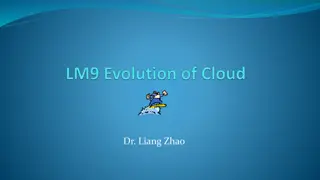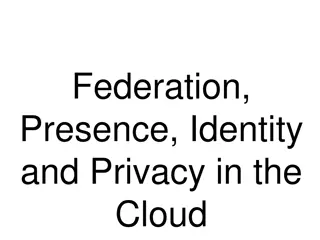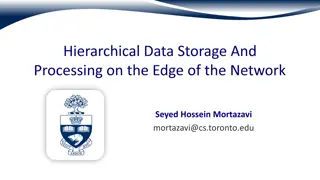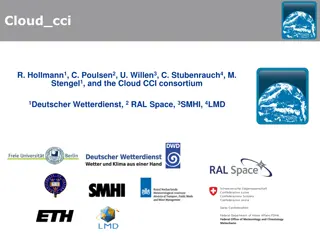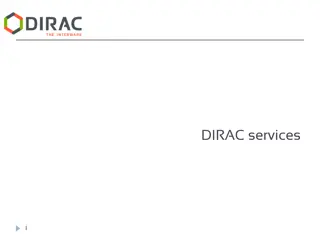Introduction to Cloud Computing: A Comprehensive Overview
Cloud computing, a transformative technology, enables easy access to applications and data from anywhere in the world, promoting collaboration and efficiency. This chapter delves into the fundamentals of cloud computing, distinguishing it from traditional desktop computing and network computing. Understanding what cloud computing is—and what it is not—is crucial for grasping its significance in our modern digital landscape.
Download Presentation

Please find below an Image/Link to download the presentation.
The content on the website is provided AS IS for your information and personal use only. It may not be sold, licensed, or shared on other websites without obtaining consent from the author.If you encounter any issues during the download, it is possible that the publisher has removed the file from their server.
You are allowed to download the files provided on this website for personal or commercial use, subject to the condition that they are used lawfully. All files are the property of their respective owners.
The content on the website is provided AS IS for your information and personal use only. It may not be sold, licensed, or shared on other websites without obtaining consent from the author.
E N D
Presentation Transcript
Author : Michael Miller Pearson Publication
Chapter -1 Beyond the Desktop : An Introduction to Cloud Computing Brief Introduction Cloud Computing : What it is What it isn t From Collaboration to the Cloud : A short History of Cloud Computing The Network is the computer : How Cloud Computer Works Companies in the Cloud : Cloud Computing Today Why Cloud Computing Matters ?
Introduction to Cloud Computing Cloud Computing portends a major change in : how we store information run applications Cloud a nebulous assemblage of computers and servers accessed via the internet. Cloud Computing lets you access all your applications and documents from anywhere in the world. making it easier for the group members in different locations to collaborate. Eg : Electricity produced their own electricity freestanding generators later bought electricity from utility at much lower price.
PC (or) Desktop Centric (or) Traditional Desktop The documents reside in the computer they were created Documents can be accessed in the network but cannot be accessed outside network DocumentCentric With cloud computing the software programs aren t run from your personal computer but are rather stored on servers accessed via the Internet. If your computer crashes the software is still available in the internet. anyone with permission cannot only access the document but can also edit and collaborate on those documents in real time
What Cloud Computing isnt ? Cloud Computing is not Network Computing In n/w computing app/doc are hosted on a single company s server & accessed over company s n/w CC encompasses multiple companies, multiple server, multiple n/w Cloud services & storage are accessible anywhere in the world over internet with n/w computing access is over company s n/w only Cloud computing is not traditional outsourcing where a company farms out its computing services to an outside firm. The documents and programs are only accessible to the company s employees via the company s network, not to the entire world via the Internet. Network Computing and Outsourcing are not cloud computing.
What Cloud Computing Is What Cloud Computing is the Key to the definition of cloud computing is the cloud itself. The cloud is a large group of interconnected computers. These computers can be personal computers or network servers; they can be public or private. For example, Google : Google hosts a cloud that consists of both smallish PCs and larger servers. Google s cloud is a private one (that is, Google owns it) that is publicly accessible (by Google s users). This cloud of computers extends beyond a single company or enterprise. The applications and data served by the cloud are available to broad group of users, cross-enterprise and cross-platform.
Access is via the Internet. Any authorized user can access these docs and apps from any computer over any Internet connection. To the user the technology and infrastructure behind the cloud is invisible. It doesn t matter whether cloud services are based on HTTP, HTML, XML, JavaScript, or other specific technologies. From Google s perspective, there are six key properties of cloud computing: 1) Cloud computing is user-centric : Once connected to the cloud as user whatever is stored there documents, messages, images, applications, whatever becomes yours. you can also share it with others.
In effect, any device that accesses your data in the cloud also becomes yours. 2) Cloud computing is task-centric: Instead of focusing on the application and what it can do, the focus is on what you need done and how the application can do it for you. 3) Cloud computing is powerful : Connecting hundreds or thousands of computers together in a cloud creates a wealth of computing power impossible with a single desktop PC. 4) Cloud computing is accessible: Because data is stored in the cloud, users can instantly retrieve more information from multiple repository . You re not limited to a single source of data, as you are with a desktop PC
5) Cloud computing is intelligent : With all the various data stored in a cloud, data mining and analysis are necessary to access that information in an intelligent manner. 6) Cloud computing is programmable : Many of the tasks necessary with cloud computing must be automated. For example, to protect the integrity of the data, information stored on a single computer in the cloud must be replicated on other computers in the cloud. If that one computer goes offline, the cloud s programming automatically computer s data to a new computer in the cloud. Most popular example applications are : redistributes that of cloud computing
Google family of applications Google Docs Spreadsheets Google Calendar Gmail Picasa All of these applications can be used for group collaboration from anywhere in the world. Cloud computing Cloud computing is a shift from computer - to user from applications - to tasks from isolated data - to data, accessed from anywhere and shared with anyone. Cloud Computing Defined - sandy.mp4 Cloud Computing Best Animation.mp4
From Collaboration to the Cloud: A Short History of Cloud Computing 1.Client/Server Computing: Centralized Applications & Storage In the antediluvian days of computing (pre-1980 or so), everything operated on the client/server model. All the software applications, all the data, and all the control resided on huge mainframe computers known as servers. Users connected to the server via a computer terminal, sometimes called a workstation or client This computer was sometimes called a dumb terminal because it didn t have any memory, storage space, or processing power Users accessed the mainframe only when granted permission In a mainframe computer, processing power was limited Access was not immediate, nor could two users access the same data at the same time.
Users had to take whatever the IT staff gave them with no variations. Customization of a report to show only a subset of the normal information? Can t do it. Want to create a new report to look at some new data? You can t do it. although the IT staff can but on their schedule, which might be weeks from now. There isn t always immediate access in a client/server environment, and seldom is there immediate gratification. client/server network architecture one or more computers are dedicated to serve the others. 2. Peer-to-Peer Computing: To connect one computer to another without first hitting the server led to the development of peer-to-peer (P2P) computing. P2P computing defines a network architecture in which each computer has equivalent capabilities and responsibilities.
In the P2P environment every computer is a client and a server there are no masters and slaves. P2P enables direct exchange of resources and services. There is no need for a central server, because any computer can function in that capacity when called on to do so - decentralizing concept. No centralized server is assigned to host the available resources and services. Arpanet guise as a peer-to-peer system that would share computing resources across the United States. Early Internet was best exemplified by the Usenet network With the development of the World Wide Web came a shift away from P2P back to the client/server model. On the web, each website is served up by a group of computers, visitors use client software (web browsers) to access it. Almost all content is centralized, all control is centralized, and the clients have no autonomy or control in the process.
3. Distributed Computing: Providing More Computing Power : idle PCs across a network or across the Internet are tapped to provide computing power for large, processor- intensive projects. It s a concept about cycle sharing between multiple computers. A personal computer, running full-out 24 hours a day, 7 days a week, is capable of tremendous computing power. Most people don t use their computers 24/7 , a good portion of a computer s resources go unused. Distributed computing uses those resources.
When a computer is enlisted for a distributed computing project, software is installed on the machine to run various processing activities when PC unused. The results of that spare-time processing are periodically uploaded to the distributed computing network, and combined with similar results from other PCs in the project. The result is necessary for some very large and complex computing projects. practical application of distributed computing : appeared in 1988, when researchers at the DEC (Digital Equipment Corporation) System Research Center developed software that distributed the work to factor large numbers among workstations within their laboratory.
By 1990, a group of about 100 users, utilizing this software, had factored a 100-digit number. By 1995, this same effort had been expanded to the web to factor a 130-digit number. In 1997 employed thousands of personal computers to crack encryption codes. In May 1999 millions of individual computers were linked together to search for intelligent life in outer space. Other, larger, projects utilize the computers of everyday Internet users, with the computing typically taking place offline, and then uploaded once a day via traditional consumer Internet connections.
4. Collaborative Computing: Working as a Group From the early days there has been a desire for multiple users to work simultaneously on the same computer- based project. This type of collaborative computing is the driving force behind cloud computing. Early group collaboration was enabled by the combination of several different P2P technologies. The goal is to enable multiple users to collaborate on group projects online, in real time. In today s environment, this means instant messaging for text-based communication with options for voice and picture communication In addition, users must be able to share files Real-time white boarding is in corporate and education environments.
5. Cloud Computing: The Next Step in Collaboration With the growth of the Internet, there was no need to limit group collaboration to a single enterprise s network environment. Users from multiple locations within a corporation, and from multiple organizations, desired to collaborate on projects that crossed company and geographic boundaries. To do this, projects had to be housed in the cloud of the Internet, and accessed from any Internet-enabled location. The concept of cloud-based documents and services took wing with the development of large server farms, such Google and other search companies
Google already had a collection of servers that it used to power its massive search engine; why not use that same computing power to drive a collection of web-based applications. IBM, Sun Systems, and other big iron providers are offering the hardware necessary to build cloud networks. On the software side, dozens of companies are developing cloud-based applications and storage services. Today, people are using cloud services and storage to create, share, find, and organize information of all different types. Tomorrow, this functionality will be available not only to computer users, but to users of any device that connects to the Internet mobile phones, portable music players, even automobiles and home television sets.
Understanding Cloud Architecture The cloud is a collection of computers and servers that are publicly accessible via the Internet. This hardware is typically owned and operated by a third party on a consolidated basis in one or more data center locations. The machines can run any combination of operating Systems. Individual users connect to the cloud from their own personal computers or portable devices, over the Internet.
To these individual users, the cloud is seen as a single application, device, or document. The hardware in the cloud (and the operating system that manages the hardware connections) is invisible. Cloud architecture require some intelligent management to connect all computers together and assign task processing to it.
Front-end interface the users select a task or service (either starting an application or opening a document). System management finds the correct resources and then calls the system s appropriate provisioning services.
Provisioning Services. These services carve out the necessary resources in the cloud, launch the appropriate web application Web application either creates or opens the requested doc. After the web application is launched the system s monitoring and metering functions track the usage of the cloud so that resources are apportioned and attributed to the proper user.
Understanding Cloud Storage With cloud storage, data is stored on multiple third- party servers, rather than on the dedicated servers used in traditional networked data storage . When storing data, the user sees a virtual server that is the data is stored just as a pseudonym used to reference virtual space carved out of the cloud. the user s data could be stored on any one or more of the computers used to create the cloud. The actual storage location may even differ from time to time as the cloud dynamically manages available storage space.
But even though the location is virtual, the user sees a static location for his data and can actually manage his storage space as if it were connected to his own PC. Cloud storage has both financial and security-associated advantages. Financially, virtual resources in the cloud are cheaper than dedicated physical resources connected to a personal computer or network. As for security, data stored in the cloud is secure from accidental erasure or hardware crashes, because it is duplicated across multiple physical machines since multiple copies of the data are kept continually, the cloud continues to function as normal If one machine crashes, the data is duplicated on other machines in the cloud.
Understanding Cloud Services Any web-based application or service offered via cloud computing is called a cloud service. Cloud services can include anything from calendar and contact applications to word processing and presentations. Many companies today, from Google to Amazon to Microsoft are developing various types of cloud services. With a cloud service, the application is hosted in the cloud. An individual user runs the application and the browser accesses the cloud service. Once launched, the web-based application behaves like a standard desktop application. The only difference is that the application and the working documents remain on the host s cloud servers.
because documents are hosted in the cloud, multiple users can collaborate on the same document in real time, using any available Internet connection. Documents are no longer machine-centric, instead, they re always available to any authorized user.
Companies in the Cloud: Cloud Computing Today the most noticeable company currently embracing the cloud computing model is Google. Google offers a powerful collection of web-based applications cloud-based word processing (Google Docs), presentation software (Google Presentations), Email (Gmail), Calendar/scheduling functionality (Google Calendar), Google is adept in getting all of its web-based applications to interface with each other; their cloud services are interconnected to the user s benefit.
Microsoft offers its Windows Live suite of web-based applications, Live Mesh initiative that links together all types of devices, data, and applications in a common cloud-based platform. Amazon has its Elastic Compute Cloud (EC2) a web service that provides cloud-based resizable computing capacity for application developers. IBM has established a Cloud Computing Center to deliver cloud services and research to clients. Numerous smaller companies have launched their own web based applications, primarily (but not exclusively) to exploit the collaborative nature of cloud services.
Why Cloud Computing Matters ? There are many implications of cloud technology, for both developers and end users. For Developers, cloud computing provides increased amounts of storage processing power to run the applications developed enables new ways to access information, process and analyze data Connect people and resources from any location anywhere in the world. In it takes the lid off the box, with cloud computing, developers are no longer boxed in by physical constraints.
For End Users His applications and documents can be accessed wherever he is, whenever he wants. Gone is the fear of losing data if a computer crashes. Documents hosted in the cloud always exist, no matter what happens to the user s machine. benefit of group collaboration, Users from around the world can collaborate on the same documents, applications, and projects, in real time.
Cloud computing does all this at lower costs because the cloud enables more efficient sharing of resources With cloud computing, hardware doesn t have to be physically adjacent to a firm s office or data center. Cloud infrastructure can be located anywhere, Including areas with lower real estate and electricity costs. IT departments don t have to engineer for peak-load capacity, because the peak load can be spread out among the external assets in the cloud. additional cloud resources are ready so the companies no longer have to purchase assets for infrequent intensive computing tasks. processing power is accessible on a cost-efficient basis.





